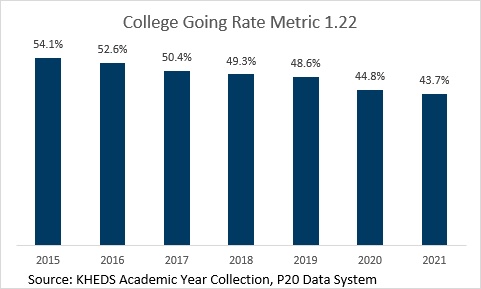By RAEGAN NEUFELD
Tiger Media Network
It took less than 10 years for the college-going rate to drop by 10 percent in the state of Kansas.
In 2015, 54.1% of high school graduates went to a public university, community college or technical college the fall after their graduation. In 2021, that number dropped to 43.7%. Some of the causes include the effects of the COVID-19 pandemic and better opportunities to enter the workforce immediately after high school.
As a result, enrollment across public universities and community colleges has declined during the past 10 years. Technical colleges were seeing a continual increase in enrollment until the pandemic, but still maintained a positive change throughout the same period, according to the Kansas Board of Regents’ annual enrollment report published in March.
According to Blake Flanders, president and CEO of the Kansas Board of Regents, a decreased enrollment can lead to institutions having too large of a “footprint,” meaning their facilities and programs are inefficient.
“The board’s been leading an initiative and program review in cooperation with the universities, and also has been advocating successfully for dollars to go towards (facility) demolition,” Flanders said. “So these are a couple of things the board’s doing to make that footprint efficient.”
A lower college-going rate also affects recruiting. Jon Armstrong has seen this in his work as the director of admissions at Fort Hays State University.
“We’re all fighting for the same students,” he said. “It’s very competitive. Everyone’s pulling out all the stops to make themselves stand out and to make the value of going to college better.”
For FHSU and other KBOR schools, one of the goals for this year is to make higher education more accessible. Current efforts include removing barriers in the admissions process, such as the requirement of a standardized test score and an application fee. The state is also working to offer more financial assistance to students.
“The Kansas Board of Regents schools were allocated a certain amount of money this past summer,” Armstrong said. “They’re all making decisions on how they’re helping Kansans. At Fort Hays, we are helping students one-on-one, not only on campus but also online. They’re Kansans in need that we want to help either come to school or stay in school.”
In the end, however, Armstrong just wants students to pursue some form of higher education.
“If people understand the value of having a certification, degree, graduate degree or doctorate, and advancing their education, Kansas is going to be strong,” he said. “That’s the goal.”
KBOR schools are seeing a slight increase in enrollment from last year to this year. According to Flanders, enrollment is up 2% systemwide.
Despite there being better opportunities to enter the workforce after high school graduation, research shows it’s better economically to complete a degree. Based on a workforce outlook report presented to KBOR in September, more than 36,000 jobs added to the Kansas economy through 2030 will require a bachelor’s degree.
“It’s important to the Kansas economy that we have that kind of highly trained, highly educated workforce,” Flanders said. “It’s also important for Kansans that they are in jobs that can sustain a family here and they can live and work in Kansas.”
Flanders cited opportunities for early college as one way KBOR is promoting higher education. High school students can enroll in college courses that will count towards both their high school diploma and college credits, such as English composition, college algebra and public speaking.
“What that does for a first-generation student whose parents didn’t go to college, or for someone who is uncertain about college, is it gives them an opportunity to know that this is something that they can do,” Flanders said. “That they can be successful in college. We think it will help our college-going rates long-term.”
According to Kansas Commissioner of Education Randy Watson, past research by the Georgetown University Center on Education and the Workforce shows approximately 70% of the Kansas job market requires some sort of education past high school. Half require a bachelor’s degree or higher, while the other half require associate degrees or certificates.
To support this, KSDE encourages individual plans of study for every student, to help them figure out what their career interests are and how they might pursue them.
“We’re really trying to help every school district develop an individual plan of study that encourages students to look at post-secondary options, because generally those options will help students gain better economic footing,” Watson said.
Amy Miller, a counselor at Hays High School, sees individual study plans that include CNA or CMA certifications and auto mechanic certifications through partnerships with FHSU and North Central Kansas Technical College. The programs are offered to high school students at a lower cost.
“The whole premise behind it is just to get kids more focused so they can get into college and get out into the workforce sooner,” she said.
Miller also works with students on how to be wise consumers of education. With increasing costs, post-secondary education can be a financial burden. She wants to make sure students utilize all of the aid available.
“It used to be four years or bust,” she said. “Everybody went to a four-year college. Well, then I think people were graduating with a four-year degree, a lot of student loan debt and couldn’t find jobs. So some were going on to get a master’s, some were moving into the basements of parents to try to get some support until they got their feet on the ground again. I think that is maybe still fresh in some people’s minds.”
For Watson, more education generally provides more for a student in the long run.
“You can find exceptions to that by major,” he said. “But, if you just looked at all the baccalaureate degrees, all the master’s degrees, all the associate degrees, all the people that have a certificate, all of those, the more education you have, the better.”

